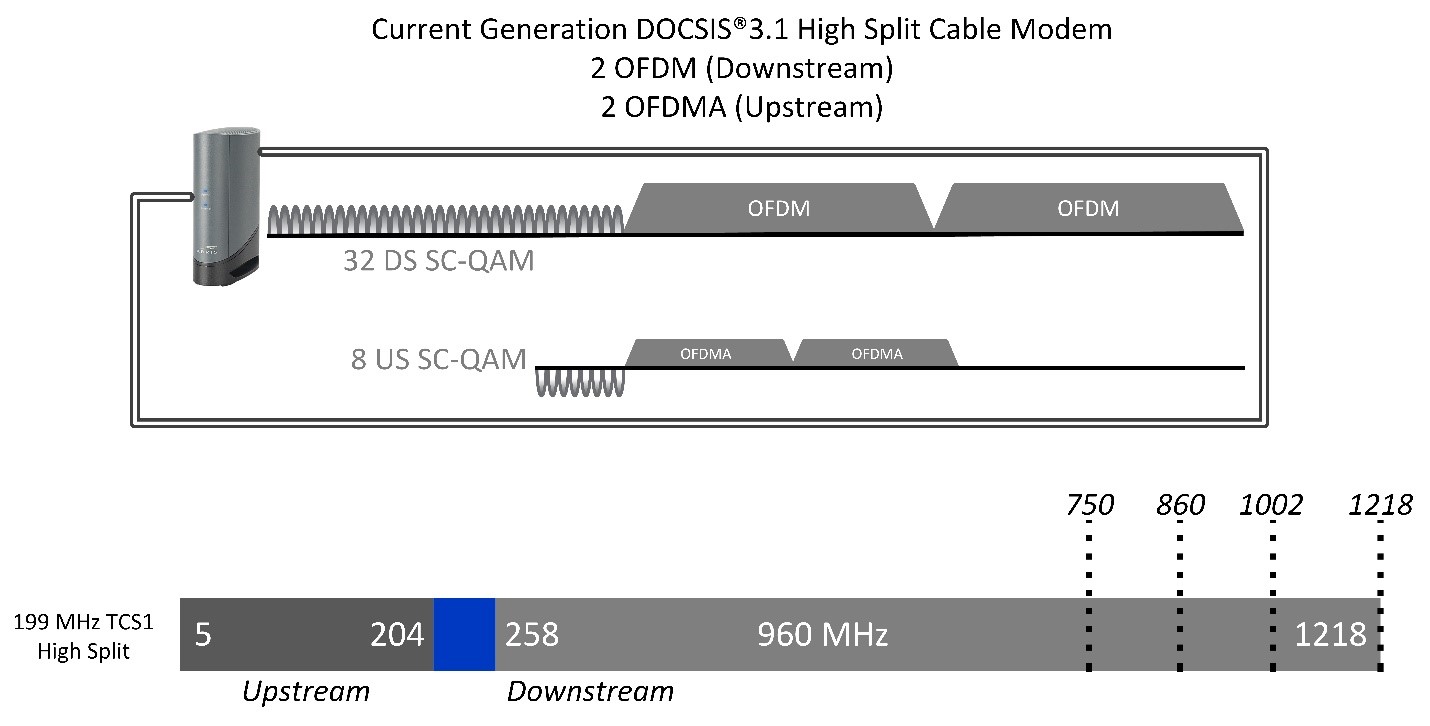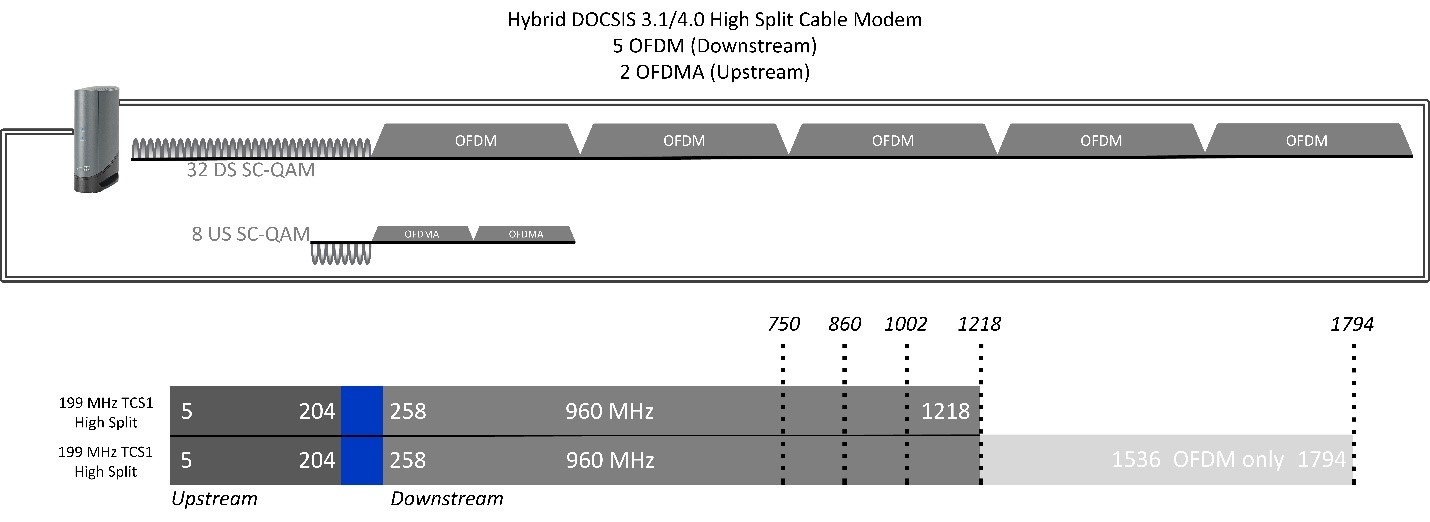Hybrid DOCSIS® 3.1/4.0 configuration is the CableLabs® endorsed name for a simple, cost-effective solution that can quickly and efficiently improve the maximum speeds of the broadband services currently available on existing DOCSIS 3.1 networks, without having to significantly upgrade existing network infrastructure. The Hybrid DOCSIS 3.1/4.0 configuration utilizes DOCSIS 4.0 cable modems and gateways to support higher-speed service tiers, allowing cable providers to target upgrades surgically for subscribers who order these services. With existing CMTS or Nodes that support Hybrid DOCSIS 3.1/4.0, no Outside Plant network upgrades are required for increased downstream capacity to customers This simple switch from deploying DOCSIS 3.1 CPE devices to deploying DOCSIS 4.0 CPE devices offers a way to enhance your current network’s ability to support services with downstream throughputs of 8 Gbps or higher, allowing you to keep pace with competitors while minimizing upgrade costs and service disruption. At the same time, the Hybrid DOCSIS 3.1/4.0 configuration can maximize the return on your investment in 204/258 MHz high-split upgrades for your current 1.2 GHz DOCSIS 3.1 network by extending their usefulness for years to come. As Downstream:Upstream ratios are currently at 15+:1 new demand for more downstream speed per Serving Group is the key value of this CPE led strategy on the way, potentially, to a full DOCSIS 4.0 end to end solution as the next step.
The Hybrid DOCSIS 3.1/4.0 configuration leverages capacity design improvements to the silicon (SoC) in DOCSIS 4.0 modems and gateways. The performance capabilities of current generation DOCSIS 3.1 devices, next-generation DOCSIS 4.0 devices, and Hybrid DOCSIS 3.1/4.0 deployments depend on the number of OFDM (in the downstream) and OFDMA (in the upstream) channels the device supports. This support, in turn, depends on the switches and diplex filters the device uses to operate in your network configuration. Current generation DOCSIS 3.1 modems, for example, only support up to two (2) OFDM channel blocks at up to 192 MHz in the downstream and up to two (2) OFDMA channel blocks at up to 96 MHz in the upstream in an 85/108 MHz mid-split or a 204/258 MHz high-split network. While DOCSIS 3.1 did not define a limitation on the number of OFDM channels supported, DOCSIS 3.1 CPE devices were only manufactured to support 2xOFDM DS channels because of the technology capabilities at that time as well as cost efficiencies.

Next-generation DOCSIS 4.0 modems, on the other hand, can support up to five (5) OFDM channel blocks at up to 192 MHz in the downstream and up to seven (7) OFDMA channel blocks at up to 96 MHz in the upstream in ultra-high-split DOCSIS 4.0 networks.

DOCSIS 4.0 modems/gateways can operate on either current DOCSIS 3.1 mid- and high-split networks (when equipped with the proper diplex filters and switches) or ultra-high split DOCSIS 4.0 networks. The Hybrid DOCSIS 3.1/4.0 configuration leverages the Downstream increased OFDM capabilities of DOCSIS 4.0 devices to boost the Downstream network capacity of a 204/258 MHz high-split network. Operating with Hybrid DOCSIS 3.1/4.0 configuration, it is possible to expand the downstream to 5 OFDM channel blocks at up to 192 MHz, subject to the existing deployment of appropriate hardware-based CMTS/I-CCAP (such as E6000® CER), CCAP Core with a Remote PHY Device (RPD)/Remote MACPHY Device (RMD), or virtual CCAP Core (such as vCore) with RPD support. Note that Hybrid DOCSIS 3.1/4.0 CMTS-related support varies by vendor and typically requires a CMTS/CCAP software upgrade from those versions currently deployed. CommScope has successfully demonstrated this capability on today’s three most common access architectures: I-CCAP, Remote PHY (with both the E6000 as a CCAP Core (eCore) and our vCore (vCMTS) products), and Remote MAC-PHY.

The Hybrid DOCSIS 3.1/4.0 configuration’s expanded 5x2 OFDM/A capability supports improvements in downstream throughput, as shown in the table below.
This bandwidth improvement supports the immediate roll-out of new, premium high-tier services for existing customers using your current network (5Gbps/1Gbps service offerings for example is possible with typical service group sizes and take rates). This has immediate, as well as long-term strategic and economic benefits. For example, premium service offerings may help you more easily compete with PON service offerings. In addition, this may increase revenue, which in turn can shorten the time it takes to finance the improvements needed for full DOCSIS 4.0 operation if you so choose.
If you are planning to upgrade your network for full DOCSIS 4.0 operation, you can offer a higher-tier service ahead of DOCSIS 4.0 deployment by using DOCSIS 4.0 modems/gateways operating in Hybrid DOCSIS 3.1/4.0 mode. When DOCSIS 4.0 is rolled out, you can leverage the DOCSIS 4.0 CPE devices that are already in the home to offer even higher tiers of service than were supported by Hybrid DOCSIS 3.1/4.0 operation. In addition, this “early roll-out” approach may provide you with important analytics about which customers are most likely to purchase DOCSIS 4.0 services—an important insight into which areas of your network you should first prioritize for DOCSIS 4.0 upgrades.
Even if you do not have any plans to upgrade your network for DOCSIS 4.0 operation, the Hybrid DOCSIS 3.1/4.0 approach still allows you to improve high-speed data tiers and boost the performance available on your current DOCSIS 3.1 architecture. Optimized Hybrid DOCSIS 3.1/4.0 only modems/gateways (i.e., DOCSIS 4 CPE with the components required for ultra-high split removed, based on your network requirements) can reduce your cost per device if you have no expectation of a future upgrade to ultrahigh split operation.
Along with improved network speeds, the Hybrid DOCSIS 3.1/4.0 configuration can improve customer experiences and satisfaction in other performance areas. DOCSIS 4.0/Hybrid DOCSIS 3.1/4.0 gateways, for example, may feature the latest dual-band or tri-band Wi-Fi™ 7 capability. By accelerating throughput, reducing latency, and improving reliability (among other features), Wi-Fi 7 delivers the improved bandwidth performance of the network around the home to the end device.
The Hybrid DOCSIS 3.1/4.0 configuration can also accelerate the adoption of IPTV services. By eliminating MPEG QAM video channels, you can reclaim either 6 or 8 MHz (depending on your channel configuration) in the downstream band. Using the Hybrid DOCSIS 3.1/4.0 configuration’s expanded OFDM downstream capacity, you can reassign that portion of the downstream spectrum to an OFDM carrier. This modification is not possible with a standard DOCSIS 3.1 device, because the device is already operating at maximum downstream capacity—that is, two OFDM carriers and 32 SC-QAM channels.
In conclusion, the Hybrid DOCSIS 3.1/4.0 configuration offers an excellent way to implement premium, multi-gigabit high-speed data services for your customers without having to commit capex costs and Opex resource costs to significant and costly infrastructure improvements. It is a bridge between today and tomorrow’s full DOCSIS 4.0 solution: Whether you adopt the Hybrid DOCSIS 3.1/4.0 configuration as an intermediate step towards full DOCSIS 4.0 operation, or if you simply wish to maximize your current (and future) DOCSIS 3.1 network capacity, the Hybrid DOCSIS 3.1/4.0 configuration provides the performance improvements you will need to keep pace with both the consumer demand for premium services and your competitors’ ability to deliver the same.
[1] These numbers are approximate; your actual results may vary.
CommScope and the CommScope logo are registered trademarks of CommScope and/or its affiliates in the U.S. and other countries. A list of CommScope trademarks is available at https://www.commscope.com/trademarks. All other product names, trademarks and registered trademarks are property of their respective owners. DOCSIS is a registered trademark of Cable Television Laboratories, Inc. Wi-Fi is a trademark of the Wi-Fi Alliance.
CommScope offers a full, end-to-end portfolio of DOCSIS 3.1 and DOCSIS 4.0 products and solutions inside and outside plant operation. For further information about hybrid DOCSIS 3.1/4.0 configurations, contact your CommScope Sales Representative.








